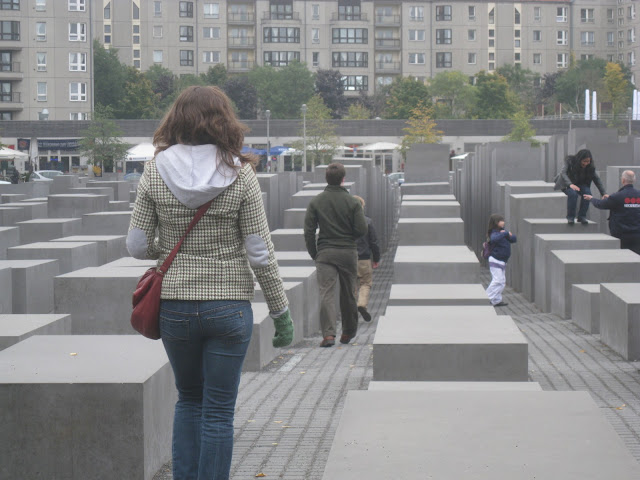In early October, AMBEX visited the sites relevant to the German Reformation. Our 9-day trip was educational and eventful and we had a lovely time together as a group. We gained a greater appreciation for Germany's art, history, culture and determination to seek the truth of Scripture.
First stop on the way to Dresden was Flossenbuerg Concentration Camp Memorial. Not much is left of the site but a few of the administrative buildings. While we were there we ran into a camera crew shooting a documentary with a survivor of this camp. It was really touching to hear his story.
Walking around the camp was so sobering. It was difficult to connect the atrocities of this place with the beautiful fall leaves and surrounding creation. One of the plaque's in the museum stated "where was God in this?" Dr. Behle, our Ref History professor discussed God's presence even in times of greatest affliction.
The US military liberated Flossenbuerg in 1945.
Dresden - the Florence of Germany
Many of us were able to snag tickets to a Tchaikovsky piano concert in the world famous "Frauenkirche" upon our arrival.
The view from our seats.
The following day we went on a walking tour of Dresden's old city. Dresden in the 20th century was a leading European center of art, classical music, culture and science until its complete destruction through fire bombs on 13 February 1945. Since then the city has largely been rebuilt in its original splendor. Today it is counted to UNESCO's world heritage sites.
Here is the group at the Luther statue in the square outside of the "Frauenkirche". The "Frauenkirche" is considered equal to St. Peter's Basilica at the Vatican in respect to Protestantism.
 |
| Dresden is known for the creation and production of Meissen Porcelain. The brand was first introduced in 1710 and dominated Europe's porcelain production throughout the 17th Century. |
To the left of Kirsten you can see the world’s largest porcelain wall frieze. It depicts the Wettin rulers of Saxony over a period of more than 800 years. The 102 metre-long frieze has a surface area of 957 m² and is made up of almost 25,000 Meissen porcelain tiles.
Walking to the only Catholic Church in Dresden - the Hofkirche. In 1697 Augustus II the Strong, Elector of Saxony, converted to Catholicism so he could become King of Poland.
At first, the king used a royal chapel for catholic services, but when the protestant city of Dresden built the "Frauenkirche" in 1743, Augustus the Strong's son Augustus III decided a catholic church was needed to counterbalance the protestant church.
In secrecy plans were made for the largest church in Saxony - the Hofkirche.Kacey and Kristen at the "Hofkirche"
The girls getting ready to enter the "Old Masters" art gallery at the Zwinger Palace. Among the primary focuses of its holdings are Italian painting of the Renaissance and Baroque as well as Dutch and Flemish painting originating largely in the 17th century. A few of the more notable artists on display include Rembrandt, Raphael, Titian, Peter Paul Rubens, Vermeer, Lucas Cranach, Jean Etienne Liotard and Bernardo Bellotto.
Cute girls - Zwinger palace in the background
Berlin Wall Document Center - we stopped and talked about the history and construction
Remaining piece of the wall in downtown Berlin
The pillars offered pictures and explanations about life behind the "iron curtain".
These plaques commemorated those who were killed trying to escape Communism.
The "Reichstag" or Germany's Congress. This building holds significant historical value specifically leading up to WWII. The glass dome at the top is open for viewing and symbolizes transparency and the people's rule over Congress.
Brandenburg Gate - this used to be a major dividing point between East and West Berlin. The gate was in the East, the wall was built just a few feet away from it.
The American Embassy - just one block from Brandenburg Gate and the Reichstag
Holocaust Memorial in Berlin - the area is vast; stones represent caskets.
The Pergamon is one of the leading and most impressive antiquities museums in the world. It houses the Pergamon Altar, the Market Gate of Miletus and the Ishtar Gate which were all transported to Berlin from Turkey in the late 1800's.
That evening we arrived in Wittenberg, Luther city! Right away we checked out the door where Martin Luther posted the 95 Thesis. It's not the original, but this one has all the thesis in scripted in bronze.
Luther House - out front is a statue of Katharina von Bora, Luther's spouse & housewife extraordinaire.
Inside the Castle Church where Luther preached
Choir stalls in the Castle Church, Wittenberg
AMBEX Reformation History Professor, Dr. Greg Behle & AMBEX Director, Jerry Orr in Wittenberg's Castle Church
Climbing the tower of the Castle Church. So many steps, and so little space!


























No comments:
Post a Comment